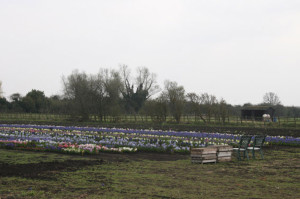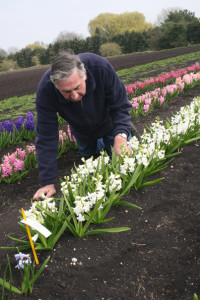Although the Netherlands through the centuries was and now still is the hyacinth bulb producer par excellence, today the largest collection of rare hyacinths in the world grows in an almost polder-like landscape in the village of Waterbeach, (Cambridgeshire, UK). Just to the north of the university town of Cambridge, Alan Shipp keeps the national hyacinth collection of the U.K. Each year at the end of March he holds a weekend-long open house.
Long colorful rows of hyacinths contrast starkly with the dark soils in fields surrounded by low hedges on small dikes. In one direction you see long rows of hyacinths in shades of pink, red, white, yellow, apricot, purple and many tints of blue. Sweetly scented waves waft across your nose every so often. Nearby is a small train line, a few farmhouses, a big barn with a large overhang. Crates with hundreds of hyacinth bulbs for sale are piled on top of carts. In the barn is a small refreshment stand, quite some seats and tables to have tea, coffee and/or cakes or a sandwich and several cases with garden books, catalogs of growers of unusual perennials as well as the plants themselves and a booth of the National Council for the Conservation of Plants and Gardens, now known as Plant Heritage. Plant Heritage supports the 650 affiliated plant collections that are located throughout the country.
Living Catalogue
This year it was bitterly cold during the open days. Still there were many blooms in the national colours and a myriad of orange-hued hyacinths. More than 350 visitors came from far and wide to see the sweetly scented colour array. For many of these hyacinth devotees the living display catalog remains the most beautiful to pick and choose one’s favourites. Since the holder of the national hyacinth collection has held the open days for the general public, the year 2004 remains the record breaker, with almost 1100 visitors during the two days.
Colour palette
Alan Shipp (73) is a third generation farmer. His family formerly raised potatoes. Since there was not much profit in the business he decided in 1985 to go in another direction. He began as the only hyacinth grower in England with five varieties in a 200 kg lot of bulbs bought from a Dutch grower. With these he became the only bulb farmer in the U.K. growing hyacinths again after World War II, particularly the rare cultivars and species. In the meantime others also have started to grow the bulbs. From early on hyacinths had always fascinated him. Says Shipp: “The colour palette at the end of March is unequaled.” Slowly his collection expanded in the following years through contacts with other suppliers, collectors and growers in the Netherlands such as Jan S. Pennings from Breezand. In 1989 the impassioned grower was able to take over the existing national collection of about 60 varieties from Wycliffe Hall Botanic Garden at Barnard Castle in northern England. Four years later his collection was again named the national collection. The most unusual addition he obtained came through the connection with Dr. Rita Raziolyte of the University of Vilnius in Lithuania. This was a lot of 31 varieties which all had disappeared in the West since the Second World War. She had done many years of research in the countries behind the then Iron Curtain. Not only were there many botanical gardens in the region but these were also carefully inventoried and described collections.
“The colour palette at the end of March is unequaled.”
Field trials
Currently Shipp’s collection contains about 180 varieties, and as such, it is the largest collection of rare varieties in the world. They are planted in a random fashion. The double varieties are marked with a D. The method of order of planting in part remains a personal choice. Timothy Clark, well-known English garden writer and owner of a beautiful home in nearby Soham surrounded by a garden of rare perennial plants and hyacinths appropriate for a Jacobean revival style manor, would prefer to see them planted in chronological order. The national collection is in fact located on two fields, the one field with the real collection, and the other located on the far side of a small dike which holds the trial field, as well as many seedlings. Shipp was able to add two of his own varieties: ‘Miss Molly’ and ‘Snowblush’.
Grande Blanche Imperiale
The oldest hyacinth, ‘Grande Blanche Imperiale’, dates from 1798, while the youngest is barely a year or two old. He is very proud of his Royal Four: ‘King of the Blues’ (1863), ‘Queen of the Blues’ (1860), ‘Queen of Pink’ (1903) and ‘Queen of Violets’ (year of registration unknown). But perhaps he is even more proud of the double yellow hyacinth which already long ago was considered lost in the West and was obtained from his Lithuanian connection. However it is not only the older varieties that are added to Shipp’s collection garden for he also adds new varieties. “I try to keep the collection as complete as possible so the varieties currently available are also included because these also will someday be considered old”. This year he will add eight varieties, including ‘Aida’, ‘Mascarade’, and ‘Moody Blues’. Much of his commercial collection is sent to Old House Gardens, in the US, the only American supplier of historical spring and summer bulbs and tubers.
Shadow Collection
In addition to Shipp’s collection there are private collections in the U.K. of considerable size but none of the owners of these collections are involved with propagation. The same holds true for the almost complete shadow collection maintained in small numbers of each variety at RHS Plant Centre in Wisley. There is also the important collection at the Hortus Bulborum in Limmen, the Netherlands. Shipp considers the backup of genetic material terribly important. Says Shipp: “ I am concerned that despite my many attempts to communicate the Hortus Bulborum in the Netherlands has shown no interest in contact or exchanges with the U.K. National Hyacinth Collection. Both collections contain old and almost lost varieties maintained in only one location. That means that the disappearance of such a collection also means the total disappearance of that group of plants”. And he is not even talking about the genetic materials of such a collection that could be used for breeding program for new varieties of the future. “I am very convinced that there should be a back-up location, and preferably several, for all threatened plant varieties.”
” ….. so the varieties currently available are also included because these also will someday be considered old”.
In Style?
Shipp has no real explanation for the sharp reduction in numbers of existent cultivars. He guesses at several possible reasons. A hyacinth mania occurred during the middle of the 18th century, during the era of Madame De Pompadour, the mistress of King Louis XV. The gardens of Versailles were filled with Dutch hyacinths and hundreds of forced hyacinths decorated the palace rooms during the winter. Thanks to Madame De Pompadour’s interest there were many others, both in France among the aristocracy and in other countries, who imitated her passion. A few decades later the mania was over, just as this occurred in the seventeenth century with tulips. In Victorian England there were more than two thousand hyacinth varieties in the available assortment, while now there but a few hundred, and of these even fewer are available commercially. Aside from popular tastes, he also wonders whether cultivated hyacinths are more susceptible (to disease) as compared with cultivated tulip varieties.
Bi-colours
Among the most desired on Shipp’s wish list is the bi-coloured hyacinth “King of Great Britain”. Hopefully this one will still show up someday through his contacts in eastern Europe. He anticipates it would become the next big hit with hyacinth aficionados. Often a white or pale rose hyacinth with a colored “eye” (deep in the center of the bloom), with a historical allure, known only from the fabulous 18th century prints by Vincent van der Vinne (one of the most renowned artists that depicts in hyacinths in the Dutch history) which may be found at the National Print Room (adjacent to the Rijksmuseum) in Amsterdam and other historical collections.
Open Days
Each year there is Open House at Alan Shipp’s, usually during the final week in March. It is always recommended to check by e-mail or telephone if the days will be held as scheduled. Interested parties may also make an appointment to visit the collection at a later date in the season although there would be next to nothing to see at such time.
Practical information
There are trains from London Stansted airport direct to Cambridge. The duration of the trip is about one hour. From Cambridge there are hourly trains (direction Peterborough or Birmingham New Street) that stop at Waterbeach. From the station it is a good long walk through a landscape of small dikes, hedges and fields with almost black, very fertile alluvial soils. The pedestrian route through the interior known to the local population is difficult to find for visitors. It is also possible to take a taxi to the fields.
Alan Shipp, Waterbeach, Cambridgeshire (UK National Hyacinth Collection)
T +44 1223 57064, E alan.shipp(at)virgin.net
(May 8, 2011, Text and photographs: Leslie Leijenhorst)



